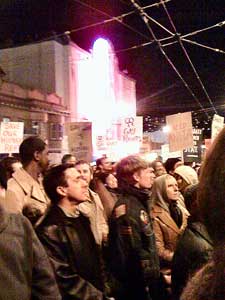WORKERS WORLD MOVIEW REVIEW
‘Milk’ keeps focus on mass struggle
By
Shelley Ettinger
Published Feb 11, 2009 3:37 PM
Often on my walk to the subway after work, I pass a group of exuberant
teenagers gathered outside a nondescript doorway in an unremarkable building in
lower Manhattan. I smile. Sometimes we kid around a little. They call me
“auntie.” The encounter always leaves me happy and hopeful.
For these are not just any teens, hanging out just anywhere. They are students
at the Harvey Milk School, New York City’s alternative public high school
for lesbian, gay, bi and trans youths. The school, the students’ sass and
confidence, our banter—all of it was made possible by the last 40 years
of struggle for LGBT rights and liberation.
|
From the movie set of ‘Milk.’
|
Some of the high points in that struggle came in the mid- to late-1970s in San
Francisco. Harvey Milk was in the thick of it, rising to national renown. As an
activist community leader and, eventually, as an elected city supervisor from
the heavily gay Castro district, Milk became a symbol of the LGBT movement. He
was also a strong advocate of linking up with the labor movement and the
anti-racist struggle.
For all this, he was assassinated. In November 1978, Dan White, a racist,
anti-gay former police officer who had just resigned from his city supervisor
post, shot Mayor George Moscone and Supervisor Harvey Milk to death inside San
Francisco City Hall.
Now, 30 years later, comes the movie “Milk.” The film is nominated
for eight Academy Awards, including Oscars for director Gus Van Sant, writer
Dustin Lance Black and actors Sean Penn in the lead role and Josh Brolin as the
killer, White.
“Milk” is a rare film for, from the viewpoint of partisans for LGBT
liberation, it deserves the acclaim it’s received. Although it is
ostensibly about the title character, this is really a movie about something
much bigger than one person.
This is a movie about an oppressed group organizing and fighting back.
The characterizations, in fact, are a bit thin. The writing doesn’t delve
all that deeply into Milk’s or any other character’s psyche. In
this movie, that is a plus, because it maintains the focus right where it
should be: on the mass struggle.
Scene after scene shows activists meeting, strategizing, taking to the streets.
In scene after scene, Milk says something along the lines of, “This
isn’t about me as an individual. This is bigger than me. This is about a
movement.”
For someone like me who took part in that movement in those days, though far
from San Francisco, watching “Milk” brings back many memories. Here
is the singer and evangelist Anita Bryant leading her “save the
children” campaign to reverse cities’ and states’ gay-rights
laws—and protesters dogging her every move. Here are the reactionaries
campaigning for California’s Briggs Initiative, which would have barred
lesbian and gay teachers from employment—and organizers mobilizing to
defeat it. Here are people by the tens of thousands pouring into the streets
time and again, refusing to be silent, refusing to be driven back into the
closet.
That’s how it really was. It’s a stirring experience to see it
enacted on screen.
The film doesn’t get everything right. Women are largely absent, even in
the crowd scenes, which is bizarre and historically inaccurate. Also, with its
emphasis on Milk, beloved and important as he was, the film omits the key role
played by more radical forces in the movement.
If the filmmakers had asked me how to end this movie, I’d have suggested
that rather than stopping at the death of Harvey Milk and that night’s
mass candlelight march, then running some informational script about the
aftermath, there should have been a final scene. It would have shown what
happened when the assassin Dan White’s infamous “Twinkie
defense”—at trial he claimed he was crazy from eating too much junk
food—won him a slap-on-the-wrist, short prison sentence.
What happened was that once more the community took to the streets of San
Francisco for Harvey Milk. Only this time their rage overflowed. Thousands
headed to City Hall, chanting, “He got away with murder,” smashing
windows, setting fire to police cars. It came to be known as the “White
Night” rebellion.
This—rebellion against injustice—is the true legacy of Harvey Milk.
We saw it in action again this past fall after the passage of the vicious
Proposition 8 in California. We’ll keep seeing it until LGBT oppression
is vanquished.
When there is no longer any need for a Harvey Milk School, when LGBT youths
don’t have to fear for their physical safety, when repression and hiding
and discrimination are bad old memories, the work of Milk and the countless,
nameless others who battled for full rights will be complete.
Articles copyright 1995-2012 Workers World.
Verbatim copying and distribution of this entire article is permitted in any medium without royalty provided this notice is preserved.
Workers World, 55 W. 17 St., NY, NY 10011
Email:
[email protected]
Subscribe
[email protected]
Support independent news
DONATE


